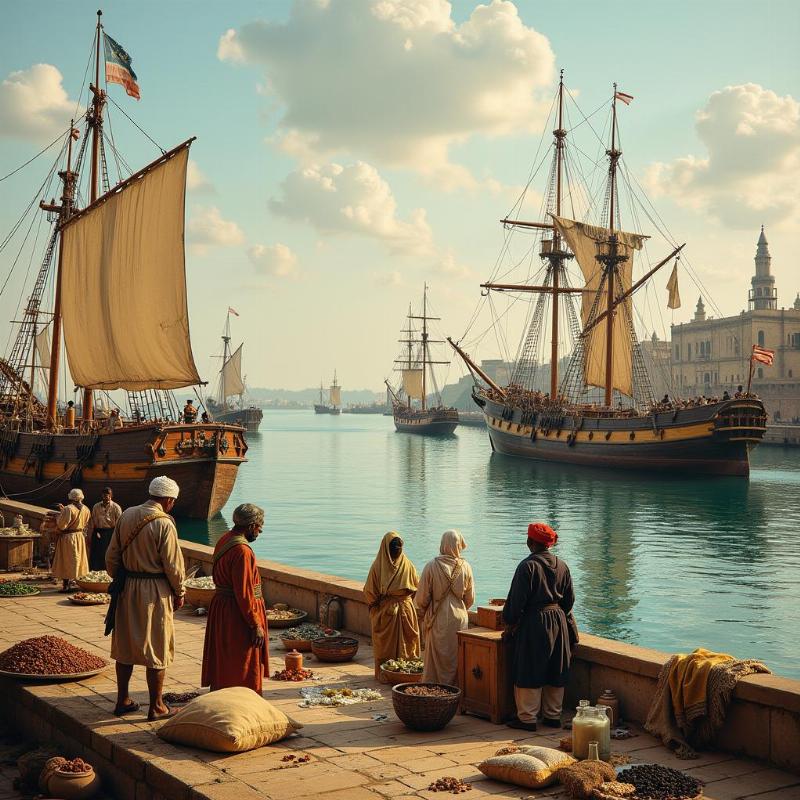Surat in the 17th century was a bustling hub of international trade, attracting merchants and travelers from across the globe. Why did people from distant lands visit Surat class 7? The answer lies in a combination of factors, from its strategic location and rich resources to its vibrant culture and tolerant atmosphere. This article will delve into the reasons behind Surat’s allure, exploring the city’s historical significance and the motivations of those who journeyed to its shores.
Surat: The Gateway to the East
Surat’s prime location on the western coast of India made it a crucial port city connecting the East and the West. Its deep natural harbor provided safe anchorage for ships, facilitating trade with countries like Persia, Arabia, Africa, and Europe. This strategic positioning established Surat as a vital link in the global trade network, drawing merchants seeking valuable commodities.
The city was renowned for its export of textiles, especially fine cotton fabrics, highly sought after in international markets. Spices, indigo, and other precious goods also flowed through Surat’s port, attracting traders eager to profit from these valuable commodities. The promise of lucrative trade deals and access to exotic goods acted as a powerful magnet for people from distant lands.
 Surat Port in the 17th Century
Surat Port in the 17th Century
A Melting Pot of Cultures
Surat’s cosmopolitan nature was another major draw for visitors. The city embraced a diverse population of Indians, Arabs, Persians, Europeans, and others, fostering a vibrant cultural exchange. This melting pot of cultures created a unique and stimulating environment, attracting travelers interested in experiencing different lifestyles and traditions.
The city was known for its religious tolerance, welcoming people of various faiths. This atmosphere of acceptance provided a safe haven for those seeking refuge from persecution or simply wishing to practice their religion freely. This welcoming environment further enhanced Surat’s appeal as a destination for people from diverse backgrounds.
Opportunities and Prosperity
Surat offered numerous opportunities for economic advancement, attracting individuals seeking their fortune. The booming trade industry created a demand for skilled laborers, merchants, and artisans, drawing people from various parts of the world in search of employment and prosperity.
The city’s wealth also attracted investors and entrepreneurs seeking to capitalize on the flourishing economy. This influx of capital further fueled Surat’s growth and development, reinforcing its reputation as a land of opportunity.
Surat’s Decline
While Surat enjoyed a period of unprecedented prosperity in the 17th century, the city eventually faced decline due to several factors. The rise of Bombay (now Mumbai) as a competing port city, the shifting trade routes, and the political instability in the region contributed to Surat’s gradual decline in prominence. However, its legacy as a significant global trading center and a melting pot of cultures remains an important part of its history.
Conclusion
The allure of Surat in the 17th century stemmed from its strategic location, rich resources, vibrant culture, and tolerant atmosphere. It was a city where people from distant lands converged for trade, seeking opportunities and experiencing a unique blend of cultures. Understanding why people visited Surat provides a fascinating glimpse into its rich history and its significance in the global landscape of that era.
FAQ
- What were the main goods traded in Surat? Textiles, especially cotton fabrics, spices, indigo, and precious stones were among the main goods traded in Surat.
- Why was Surat’s location important? Surat’s location on the western coast of India, with its deep natural harbor, made it a vital port city connecting the East and the West.
- What was the cultural atmosphere like in Surat? Surat was a cosmopolitan city with a diverse population and a tolerant atmosphere, welcoming people of various faiths and backgrounds.
- What contributed to Surat’s decline? The rise of Bombay as a competing port, shifting trade routes, and political instability contributed to Surat’s decline.
- Why is Surat’s history important to learn about? Surat’s history offers valuable insights into global trade patterns, cultural exchange, and the rise and fall of prominent trading centers.
About PlaTovi
PlaTovi is your one-stop solution for all your travel needs, specializing in crafting unforgettable travel experiences within India and internationally. We offer a wide range of services, from traditional tour packages encompassing sightseeing, dining, and shopping to hotel and resort bookings, international and domestic flight bookings, event and wedding planning, car rentals, and airport transfers. We also provide visa assistance and documentation support to ensure a hassle-free travel experience. For personalized travel solutions tailored to your needs, contact us at [email protected] or call us at +91 22-2517-3581. Let PlaTovi help you explore the world!